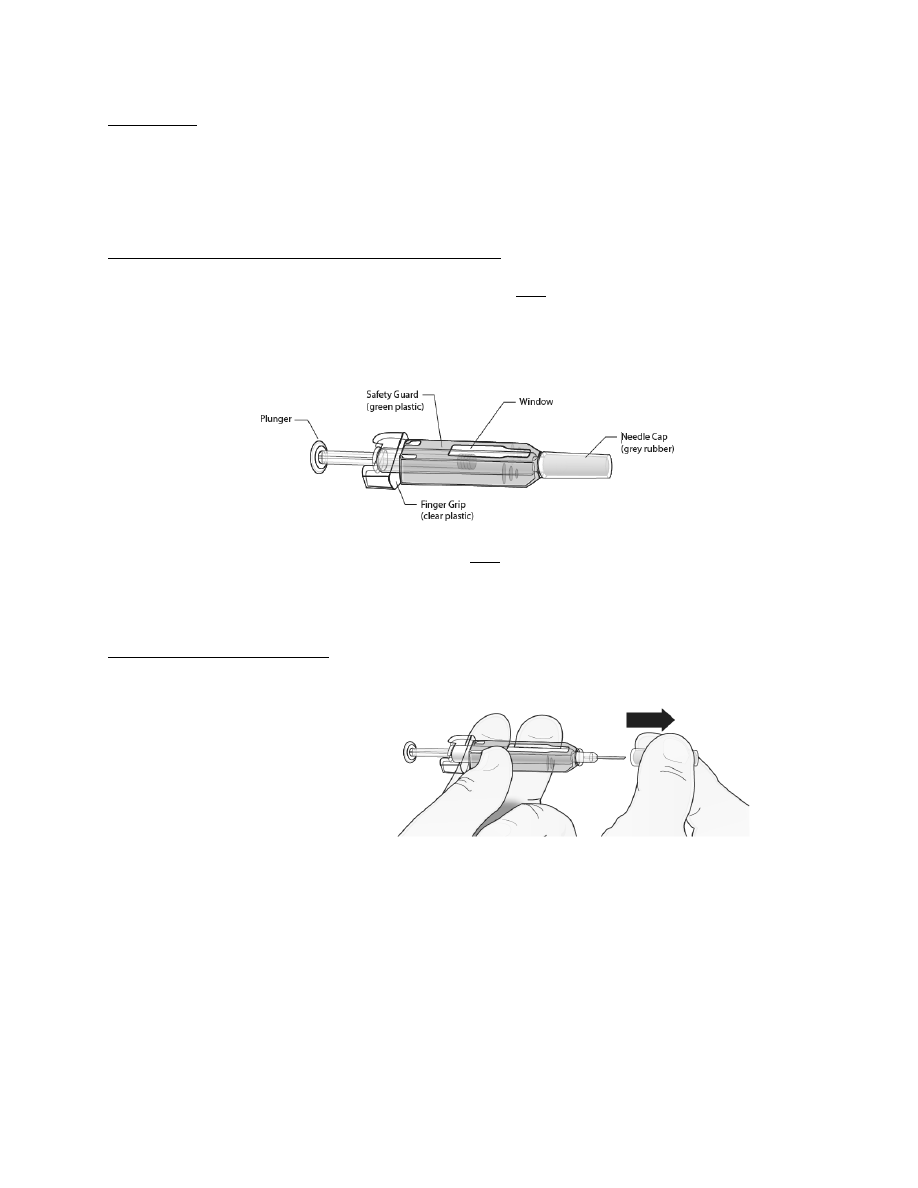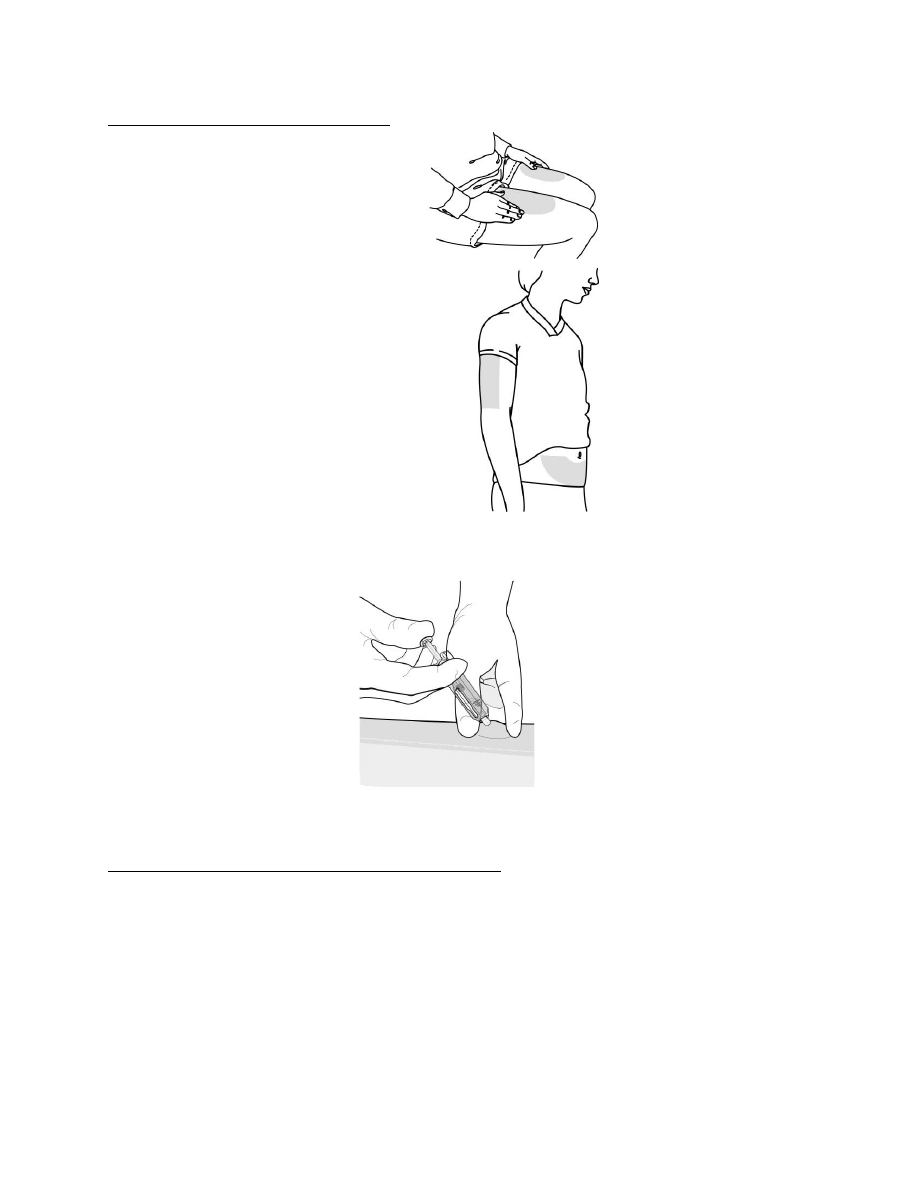ВУЗ: Казахский национальный медицинский университет им. С.Д. Асфендиярова
Категория: Не указан
Дисциплина: Медицина
Добавлен: 05.02.2019
Просмотров: 1550
Скачиваний: 2

Page 1
HIGHLIGHTS OF PRESCRIBING INFORMATION
These highlights do not include all the information needed to use
PROLIA safely and effectively. See full prescribing information for
PROLIA.
Prolia
®
(denosumab)
Injection, for subcutaneous use
Initial U.S. Approval: 2010
------------------------------RECENT MAJOR CHANGES------------------------
Warnings and Precautions (5.3)
02/2015
Warnings and Precautions (5.4)
02/2015
Warnings and Precautions (5.8)
06/2014
-------------------------------INDICATIONS AND USAGE------------------------
Prolia is a RANK ligand (RANKL) inhibitor indicated for:
Treatment of postmenopausal women with osteoporosis at high risk for
fracture (1.1)
Treatment to increase bone mass in men with osteoporosis at high risk
for fracture (1.2)
Treatment to increase bone mass in men at high risk for fracture
receiving androgen deprivation therapy for nonmetastatic prostate cancer
(1.3)
Treatment to increase bone mass in women at high risk for fracture
receiving adjuvant aromatase inhibitor therapy for breast cancer (1.4)
------------------------DOSAGE AND ADMINISTRATION----------------------
Prolia should be administered by a healthcare professional (2.1)
Administer 60 mg every 6 months as a subcutaneous injection in the
upper arm, upper thigh, or abdomen (2.1)
Instruct patients to take calcium 1000 mg daily and at least 400 IU
vitamin D daily (2.1)
-----------------------DOSAGE FORMS AND STRENGTHS--------------------
Single-use prefilled syringe containing 60 mg in a 1 mL solution (3)
Single-use vial containing 60 mg in a 1 mL solution (3)
------------------------------CONTRAINDICATIONS-------------------------------
Hypocalcemia (4.1, 5.3)
Pregnancy (4.2, 8.1)
Known hypersensitivity to Prolia (4.3, 5.2)
----------------------WARNINGS AND PRECAUTIONS-------------------
Same Active Ingredient: Patients receiving Prolia should not receive
XGEVA
®
(5.1)
Hypersensitivity including anaphylactic reactions may occur.
Discontinue permanently if a clinically significant reaction occurs (5.2)
Hypocalcemia: Must be corrected before initiating Prolia. May worsen,
especially in patients with renal impairment. Adequately supplement
patients with calcium and vitamin D (5.3)
Osteonecrosis of the jaw: Has been reported with Prolia. Monitor for
symptoms (5.4)
Atypical femoral fractures: Have been reported. Evaluate patients with
thigh or groin pain to rule out a femoral fracture (5.5)
Serious infections including skin infections: May occur, including those
leading to hospitalization. Advise patients to seek prompt medical
attention if they develop signs or symptoms of infection, including
cellulitis (5.6)
Dermatologic reactions: Dermatitis, rashes, and eczema have been
reported. Consider discontinuing Prolia if severe symptoms develop
(5.7)
Severe Bone, Joint, Muscle Pain may occur. Discontinue use if severe
symptoms develop (5.8)
Suppression of bone turnover: Significant suppression has been
demonstrated. Monitor for consequences of bone oversuppression (5.9)
----------------------------ADVERSE REACTIONS--------------------------
Postmenopausal osteoporosis: Most common adverse reactions (> 5%
and more common than placebo) were: back pain, pain in extremity,
hypercholesterolemia, musculoskeletal pain, and cystitis. Pancreatitis
has been reported in clinical trials (6.1)
Male Osteoporosis: Most common adverse reactions (> 5% and more
common than placebo) were: back pain, arthralgia, and nasopharyngitis
(6.1)
Bone loss due to hormone ablation for cancer: Most common adverse
reactions (≥ 10% and more common than placebo) were: arthralgia and
back pain. Pain in extremity and musculoskeletal pain have also been
reported in clinical trials (6.1)
To report SUSPECTED ADVERSE REACTIONS, contact Amgen Inc. at
1-800-77-AMGEN (1-800-772-6436) or FDA at 1-800-FDA-1088 or
-----------------------USE IN SPECIFIC POPULATIONS-----------------
Nursing mothers: Discontinue drug or nursing taking into consideration
importance of drug to mother (8.3)
Pediatric patients: Safety and efficacy not established (8.4)
Renal impairment: No dose adjustment is necessary in patients with
renal impairment. Patients with creatinine clearance < 30 mL/min or
receiving dialysis are at risk for hypocalcemia. Supplement with
calcium and vitamin D, and consider monitoring serum calcium (8.6)
See 17 for PATIENT COUNSELING INFORMATION and Medication
Guide.
Revised: 02/2015
FULL PRESCRIBING INFORMATION: CONTENTS*
1
INDICATIONS AND USAGE
1.1
Treatment of Postmenopausal Women with Osteoporosis at High
Risk for Fracture
1.2
Treatment to Increase Bone Mass in Men with Osteoporosis
1.3
Treatment of Bone Loss in Men Receiving Androgen Deprivation
Therapy for Prostate Cancer
1.4
Treatment of Bone Loss in Women Receiving Adjuvant
Aromatase Inhibitor Therapy for Breast Cancer
2
DOSAGE AND ADMINISTRATION
2.1
Recommended Dosage
2.2
Preparation and Administration
3
DOSAGE FORMS AND STRENGTHS
4
CONTRAINDICATIONS
4.1
Hypocalcemia
4.2
Pregnancy
4.3 Hypersensitivity
5
WARNINGS AND PRECAUTIONS
5.1
Drug Products with Same Active Ingredient
5.2
Hypersensitivity
5.3
Hypocalcemia and Mineral Metabolism
5.4
Osteonecrosis of the Jaw
5.5
Atypical Subtrochanteric and Diaphyseal Femoral Fractures
5.6
Serious Infections
5.7
Dermatologic Adverse Reactions
5.8
Musculoskeletal Pain
5.9
Suppression of Bone Turnover
6
ADVERSE REACTIONS
6.1
Clinical Trials Experience
6.2
Postmarketing Experience
6.3
Immunogenicity
7
DRUG INTERACTIONS
8
USE IN SPECIFIC POPULATIONS
8.1
Pregnancy
8.3
Nursing Mothers
8.4
Pediatric Use
8.5
Geriatric Use
8.6
Renal Impairment
8.7
Hepatic Impairment
10
OVERDOSAGE
11
DESCRIPTION
12
CLINICAL PHARMACOLOGY
12.1 Mechanism of Action
12.2 Pharmacodynamics
12.3 Pharmacokinetics
13
NONCLINICAL TOXICOLOGY
13.1 Carcinogenesis, Mutagenesis, Impairment of Fertility

Page 2
13.2 Animal Toxicology and/or Pharmacology
14 CLINICAL STUDIES
14.1 Postmenopausal Women with Osteoporosis
14.2 Treatment to Increase Bone Mass in Men with Osteoporosis
14.3 Treatment of Bone Loss in Men with Prostate Cancer
14.4 Treatment of Bone Loss in Women with Breast Cancer
16
HOW SUPPLIED/STORAGE AND HANDLING
17
PATIENT COUNSELING INFORMATION
17.1 Drug Products with Same Active Ingredient
17.2 Hypersensitivity
17.3 Hypocalcemia
17.4 Osteonecrosis of the Jaw
17.5 Atypical Subtrochanteric and Diaphyseal Femoral Fractures
17.6 Serious Infections
17.7 Dermatologic Reactions
17.8 Musculoskeletal Pain
17.9 Embryo-Fetal Toxicity
17.10 Nursing Mothers
17.11 Schedule of Administration
* Sections or subsections omitted from the full prescribing information
are not listed.

Page 3
FULL PRESCRIBING INFORMATION
1
INDICATIONS AND USAGE
1.1
Treatment of Postmenopausal Women with Osteoporosis at High Risk for Fracture
Prolia is indicated for the treatment of postmenopausal women with osteoporosis at high risk for fracture,
defined as a history of osteoporotic fracture, or multiple risk factors for fracture; or patients who have
failed or are intolerant to other available osteoporosis therapy. In postmenopausal women with
osteoporosis, Prolia reduces the incidence of vertebral, nonvertebral, and hip fractures [see Clinical
Studies (14.1)].
1.2
Treatment to Increase Bone Mass in Men with Osteoporosis
Prolia is indicated for treatment to increase bone mass in men with osteoporosis at high risk for fracture,
defined as a history of osteoporotic fracture, or multiple risk factors for fracture; or patients who have
failed or are intolerant to other available osteoporosis therapy [see Clinical Studies (14.2)].
1.3
Treatment of Bone Loss in Men Receiving Androgen Deprivation Therapy for Prostate
Cancer
Prolia is indicated as a treatment to increase bone mass in men at high risk for fracture receiving androgen
deprivation therapy for nonmetastatic prostate cancer. In these patients Prolia also reduced the incidence
of vertebral fractures [see Clinical Studies (14.3)].
1.4
Treatment of Bone Loss in Women Receiving Adjuvant Aromatase Inhibitor Therapy for
Breast Cancer
Prolia is indicated as a treatment to increase bone mass in women at high risk for fracture receiving
adjuvant aromatase inhibitor therapy for breast cancer [see Clinical Studies (14.4)].
2
DOSAGE AND ADMINISTRATION
2.1
Recommended Dosage
Prolia should be administered by a healthcare professional.
The recommended dose of Prolia is 60 mg administered as a single subcutaneous injection once every
6 months. Administer Prolia via subcutaneous injection in the upper arm, the upper thigh, or the
abdomen. All patients should receive calcium 1000 mg daily and at least 400 IU vitamin D daily
[see Warnings and Precautions (5.3)].
If a dose of Prolia is missed, administer the injection as soon as the patient is available. Thereafter,
schedule injections every 6 months from the date of the last injection.
2.2
Preparation and Administration
Visually inspect Prolia for particulate matter and discoloration prior to administration whenever solution
and container permit. Prolia is a clear, colorless to pale yellow solution that may contain trace amounts of
translucent to white proteinaceous particles. Do not use if the solution is discolored or cloudy or if the
solution contains many particles or foreign particulate matter.

Page 4
Latex Allergy: People sensitive to latex should not handle the grey needle cap on the single-use prefilled
syringe, which contains dry natural rubber (a derivative of latex).
Prior to administration, Prolia may be removed from the refrigerator and brought to room temperature (up
to 25°C/77°F) by standing in the original container. This generally takes 15 to 30 minutes. Do not warm
Prolia in any other way [see How Supplied/Storage and Handling (16)].
Instructions for Prefilled Syringe with Needle Safety Guard
IMPORTANT:
In order to minimize accidental needlesticks, the Prolia single-use prefilled syringe will
have a green safety guard; manually activate the safety guard after the injection is given.
DO NOT slide the green safety guard forward over the needle before administering the injection; it will
lock in place and prevent injection.
Activate the green safety guard (slide over the needle) after the injection.
The grey needle cap on the single-use prefilled syringe contains dry natural rubber (a derivative of latex);
people sensitive to latex should not handle the cap.
Step 1: Remove Grey Needle Cap
Remove needle cap.

Page 5
Step 2: Administer Subcutaneous Injection
Choose an injection site. The
recommended injection sites for
Prolia include: the upper arm OR
the upper thigh OR the abdomen.
Insert needle and inject all
the liquid subcutaneously.
Do not administer into muscle
or blood vessel.
DO NOT put grey needle cap back on needle.
Step 3: Immediately Slide Green Safety Guard Over Needle
With the needle pointing away from you…
Hold the prefilled syringe by the clear plastic finger grip with one hand. Then, with the other hand, grasp
the green safety guard by its base and gently slide it towards the needle until the green safety guard locks
securely in place and/or you hear a “click.” DO NOT grip the green safety guard too firmly – it will
move easily if you hold and slide it gently.
Upper Thigh
Upper Arm
Abdomen